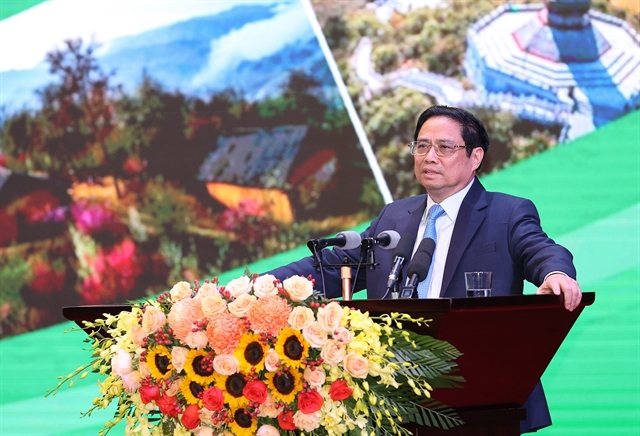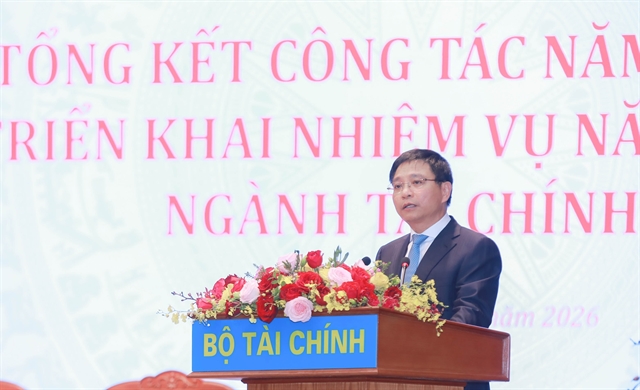 Politics & Law
Politics & Law


|
| Prime Minister Phạm Minh Chính addressed the conference on developing the northern midland and mountainous region, held on Saturday in Lào Cai Province. — VNA/VNS Photo Dương Giang |
LÀO CAI — Prime Minister Phạm Minh Chính on Saturday requested ministries, sectors and northern mountainous and midland provinces to organise the implementation of policies, and action programmes to promote socio-economic development in the region, as the Party and State have adopted sufficient and sound policies and programmes.
PM Chính made the request when chairing a conference in Lào Cai Province announcing the Government’s Action Programme implementing the Politburo’s Resolution No.11-NQ/TW on directions to intensify socio-economic development and ensure national defence and security in the northern midland and mountainous region by 2030, with a vision to 2045.
According to the leader, the region has a particularly important strategic position in terms of politics, economy, culture, society, the environment, national defence, security and foreign affairs. It also boasts a lot of potential and advantages in trading with China and other member states of the Association of Southeast Asian Nations (ASEAN).
In the past, the Party and State have issued and effectively implemented many policies to promote potential and advantages and create motivation for the development of the region. In addition, the Government and the Prime Minister have regularly directed and met with localities to discuss tasks and solutions to remove difficulties and foster their socio-economic development.
As a result, the gross regional domestic product (GRDP) has been continuously improved. The average growth rate in the 2005-20 period reached about 9.3 per cent, with the GRDP hitting VNĐ688.9 trillion (US$29.4 billion USD) and GRDP per capita being VNĐ54.1 million. Exports also increased sharply, from $3.3 billion in 2013 to $41.7 billion in 2020, with the export growth rate hitting 57.8 per cent per year.
However, potential and advantages of the region have not been properly utilised and brought into full play, PM Chính noted, adding that its competitiveness is not high, and the economic scale is still quite modest and infrastructure is still limited, especially in remote areas.
The region has 13 million people, or 13 per cent of the country’s total population, but contributed only 8.54 per cent of the national GDP.
He asked ministries, sectors and localities to focus on resources to address the existing shortcomings, particularly bottlenecks in transport infrastructure, logistics, digital transformation and climate change response; speed up the disbursement of public investment; and intensify economic restructuring associated with renewing the growth model.
The Ministry of Planning and Investment should work closely with other related ministries, sectors and localities to seek measures to boost investment promotion and attraction in the region, he said, asking for an improvement in its business and investment environment to ensure transparency, fairness and competitiveness.
Minister of Agriculture and Rural Development Lê Minh Hoan stressed the Government’s orientations for the region, which is turning into a safe, green, organic specialised agriculture producing centre.
Hoan said the pursuit of metrics like output, productivity, scale and pure growth would not mean much for the region’s competitiveness, but if the northern mountainous localities should focus on how to cultivate and utilise the potentials of add values from the distinguished features of the ethnic minorities’ cultures, from local landscapes and natural resources,
At the conference, representatives of the World Bank and the Asian Development Bank gave recommendations on sustainable poverty reduction and transport and tourism infrastructure development for the region.
Representatives from the Japan External Trade Organisation (JETRO) and the Korea International Cooperation Agency (KOICA) showed their hopes that the region will have opener policies and synchronous infrastructure so that their countries’ enterprises can expand cooperation and development.
The Prime Minister and delegates witnessed the hand-over of investment certificates and memoranda of understanding on investment cooperation in 14 northern mountainous and midland provinces, namely Hà Giang, Cao Bằng, Lào Cai, Bắc Kạn, Lạng Sơn, Tuyên Quang, Yên Bai, Thái Nguyên, Phú Thọ, Bắc Giang, Lai Châu, Điện Biên, Sơn La, and Hoà Bình. — VNS




